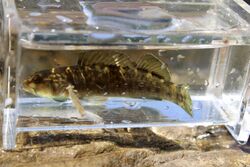Biology:Greenfin darter
| Greenfin darter | |
|---|---|

| |
| Scientific classification | |
| Domain: | Eukaryota |
| Kingdom: | Animalia |
| Phylum: | Chordata |
| Class: | Actinopterygii |
| Order: | Perciformes |
| Family: | Percidae |
| Genus: | Etheostoma |
| Species: | E. chlorobranchium
|
| Binomial name | |
| Etheostoma chlorobranchium Zorach, 1972
| |
The greenfin darter (Etheostoma chlorobranchium) is a species of freshwater ray-finned fish, a darter from the subfamily Etheostomatinae, part of the family Percidae, which also contains the perches, ruffes and pikeperches. It is endemic to the eastern United States .
Geographic distribution
The greenfin darter is primarily restricted to the fast-flowing, mountainous streams and rivers of the upper Tennessee River drainage area, in North Carolina, Georgia, and Tennessee. The species' range stretches from the upper Holston and Watauga Rivers, south through the French Broad and Little Tennessee Rivers, and ultimately ends at the Hiwassee River.[2]
Ecology
The greenfin darter is a benthic insectivore, feeding mainly on insect larvae in cold, high-elevation creeks and rivers. A study by Bryant et al. revealed the diet of the greenfin darter may be the most diverse in the genus, with some individuals' guts containing up to 15 different species of insects.[2] Its predators are mainly larger freshwater fish, such as smallmouth bass (Micropterus dolomieu) and madtoms (genus Notorus). Darters in general are important food sources for many fish.[3] Freshwater eels commonly consume adult darters, and suckerfish prey on their eggs. The species is relatively abundant, and has been found to hybridize with E. camurum and E. rufilineatum, where ranges overlap. Like many other darter species, the greenfin has adapted morphologically to reduce drag and allow stationary positioning on the substrate even in the midst of fast-flowing riffles.[4]
Life cycle
Spawning occurs from late May to early August. Females bury themselves in the substrate in areas protected from strong currents, and release eggs upon the arrival of a mate. The male may remain at the spawning site for several hours, guarding the eggs.[2] Growth is extremely rapid, with juveniles reaching 45 mm in just a year. Mean length is 62 mm, with some individuals reaching as much as 110 mm.[5] Lifespans can be up to five years. E. chlorobranchium is thought to be the largest species in the subgenus Nothonotus.[citation needed]
Environmental status
E. chlorobranchium has not been evaluated by the IUCN,[5] although it is classified as state threatened in Georgia.[6] However, the species is found and protected in the Great Smoky Mountains National Park and the Southern Appalachian Biosphere reserve.[7] Greenfin populations are certainly vulnerable to siltation, water impoundment (or any change to water velocity), and agricultural runoff. A close relative, E. camurum, has seen huge population declines due to anthropogenic environmental disturbances, and is listed as critically imperiled in several states.[8] Hybridization between E. chlorobranchium, E. camurum, and E. rufilineatum does not appear to be a threat to the species.[9] Additionally, climate change may force the greenfin into higher elevations, and into smaller streams. This will almost certainly lead to population declines.[citation needed] Because of its position as an important food source for larger fish in the Tennessee River drainage area, it is important for this species to be assessed and monitored in the future.
References
- ↑ NatureServe (2013). "Etheostoma chlorobranchium". IUCN Red List of Threatened Species 2013: e.T202463A2745093. doi:10.2305/IUCN.UK.2013-1.RLTS.T202463A2745093.en. https://www.iucnredlist.org/species/202463/2745093. Retrieved 19 November 2021.
- ↑ 2.0 2.1 2.2 Etnier, D. A., & Starnes, W. C. (1993). Fishes of Tennessee (pp. 478–479). University of Tennessee press.
- ↑ Kuehne, R., R. Barbour. 1983. The American Darters. Lexington, Kentucky: The University Press of Kentucky.
- ↑ Carlson, R.L and G.V. Lauder. 2010. Living on the Bottom: Kinematics of Benthic Station-Holding in Darter Fishes (Percidae: Etheostomatinae). Journal of Morphology (271): 25-35.
- ↑ 5.0 5.1 "Etheostoma chlorobranchium, Greenfin darter". Fishbase.org. 2012-07-03. http://www.fishbase.org/summary/SpeciesSummary.php?ID=3407&genusname=Etheostoma&speciesname=chlorobranchium. Retrieved 2013-10-19.
- ↑ "Fishes of Georgia: Fish Species Description". Fishesofgeorgia.uga.edu. http://fishesofgeorgia.uga.edu/index.php?page=speciespages/species_page&key=ethechbr. Retrieved 2013-10-19.
- ↑ "Etheostoma chlorobranchium (Greenfin darter)". Global Species. 2010-02-01. http://globalspecies.org/ntaxa/666776. Retrieved 2013-10-19.
- ↑ Smiley, P.C., R. B. Gillespie, K. W. King, and C. Huang. 2009. Management implications of the relationships between water chemistry and fishes within channelized headwater streams in the Midwestern United States. Ecohydrology (2): 294-302.
- ↑ Eisenhour, DJ. 1995. Systematics of Etheostoma camurum and E. chlorobranchium (Osteichthyes, Percidae) in the Tennessee and Cumberland River drainages with analysis of hybridization in the Nolichucky river system. Copeia 2:368-379.
External links
Wikidata ☰ Q2044379 entry
 |


